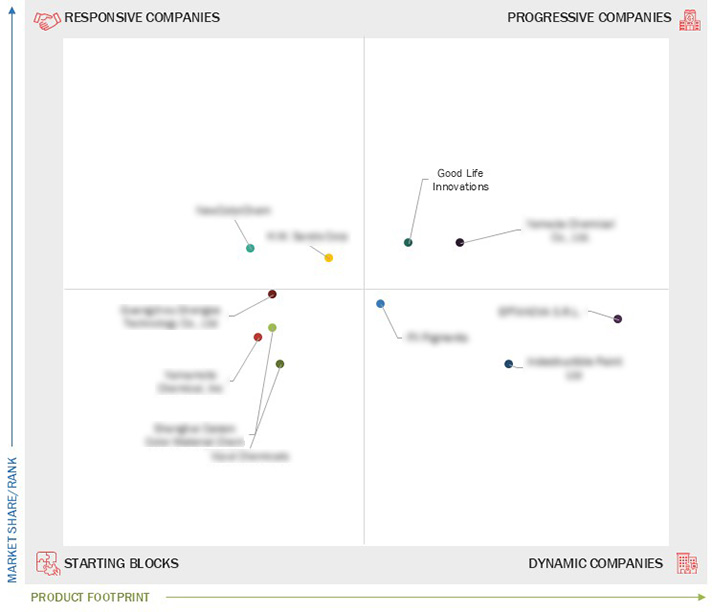Comparing 11 vendors in Chromic Materials Startups across 0 criteria.
Chromic materials are specialized compounds that change their color or properties in response to external stimuli such as light, heat, electricity, pressure, or chemical interactions. Chromic materials are categorized based on their stimulus response: photochromic materials react to light and are used in smart eyewear and UV-sensitive coatings; thermochromic materials respond to temperature changes and are applied in smart textiles , packaging, and coatings; electrochromic materials change with the electrical input, finding use in smart windows and automotive mirrors. Other variants include piezochromic materials (responding to pressure) and gasochromic materials (reacting to gases).
Market Leadership Quadrant
1.1 Study Objectives
1.2 Market Definition
1.3 Study Scope
1.3.1 Markets Covered and Regional Scope
1.3.2 Inclusions and Exclusions
1.3.3 Years Considered
1.4 Currency Considered
1.5 Unit Considered
1.6 Limitations
1.7 Stakeholders
2.1 Introduction
2.2 Market Dynamics
2.2.1 Drivers
2.2.1.1 Rising adoption in automotive and aerospace sectors
2.2.1.2 Growing demand for smart materials across industries
2.2.1.3 Advancements in flexible, interactive and energy-efficient display technologies
2.2.1.4 Sustainability and energy efficiency in construction
2.2.2 Restraints
2.2.2.1 High production costs
2.2.2.2 Limited durability of chromic materials
2.2.3 Opportunities
2.2.3.1 Rising demand for energy-efficient building solutions
2.2.3.2 Expansion of applications in automotive safety features
2.2.4 Challenges
2.2.4.1 Complex regulatory and certification processes
2.2.4.2 Limited availability of raw materials
2.3 Trends/Disruptions Impacting Customer Business
2.4 Value Chain Analysis
2.5 Ecosystem Analysis
2.6 Investment and Funding Scenario
2.7 Technology Analysis
2.7.1 Key Technologies
2.7.2 Complementary Technologies
2.7.3 Adjacent Technologies
2.8 Patent Analysis
2.9 Trade Analysis
2.10 Porter’s Five Forces Analysis
2.10.1 Threat of New Entrants
2.10.2 Threat of Substitutes
2.10.3 Bargaining Power of Suppliers
2.10.4 Bargaining Power of Buyers
2.10.5 Intensity of Competitive Rivalry
3.1 Introduction
3.2 Key Player Strategies/Right to Win
3.3 Revenue Analysis
3.4 Market Share Analysis
3.5 Company Valuation and Financial Metrics
3.6 Brand/Product Comparison
3.7 Company Evaluation Matrix: Startups/SMEs
3.7.1 Progressive Companies
3.7.2 Responsive Companies
3.7.3 Dynamic Companies
3.7.4 Starting Blocks
3.7.5 Competitive Benchmarking: Startups/SMEs
3.7.5.1 Detailed list of key startups/SMEs
3.7.5.2 Competitive benchmarking of key startups/SMEs
3.8 Competitive Scenario
3.8.1 New Product Launches
3.8.2 Deals
3.8.3 Others
4.1 NewColorChem
4.1.1 Business overview
4.1.2 Products/Solutions/Services offered
4.1.3 Recent developments
4.2 H.W. Sands Corp.
4.2.1 Business overview
4.2.2 Products/Solutions/Services offered
4.2.3 Recent developments
4.3 Yamada Chemical Co., Ltd.
4.3.1 Business overview
4.3.2 Products/Solutions/Services offered
4.3.3 Recent developments
4.4 Good Life Innovations
4.4.1 Business overview
4.4.2 Products/Solutions/Services offered
4.4.3 Recent developments
4.5 FX Pigments
4.5.1 Business overview
4.5.2 Products/Solutions/Services offered
4.5.3 Recent developments
4.6 Indestructible Paint Ltd.
4.6.1 Business overview
4.6.2 Products/Solutions/Services offered
4.6.3 Recent developments
4.7 EPTANOVA S.R.L.
4.7.1 Business overview
4.7.2 Products/Solutions/Services offered
4.7.3 Recent developments
4.8 Guangzhou Shengse Technology Co., Ltd
4.8.1 Business overview
4.8.2 Products/Solutions/Services offered
4.8.3 Recent developments
4.9 Yamamoto Chemicals Inc.
4.9.1 Business overview
4.9.2 Products/Solutions/Services offered
4.9.3 Recent developments
4.10 Shanghai Caison Color Material Co., Ltd.
4.10.1 Business overview
4.10.2 Products/Solutions/Services offered
4.10.3 Recent developments
4.11 Vipul Chemicals India Pvt. Ltd.
4.11.1 Business overview
4.11.2 Products/Solutions/Services offered
4.11.3 Recent developments



